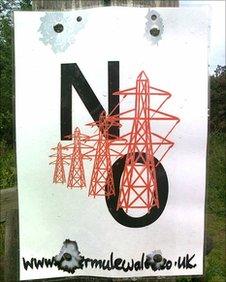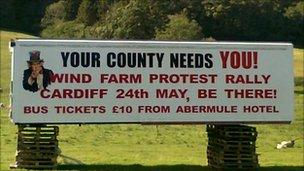Why many in rural Wales worry over power and pylons
- Published

The scheme may cost £178m, rising to £562m if cables are buried underground
People living in the Severn and Vyrnwy valleys are only beginning to wake up to the fact that existing wind farms and several other consented or planned sites, need to be connected to the National Grid.
Otherwise the power generated by ever bigger turbines in future will not be able to be used by the utility companies, and by all of us who pay these companies for providing electricity in our homes and businesses.
In mid Wales, that may mean a line of 50 metre (164ft) pylons carrying 400,000 volt electricity cables from Montgomeryshire to near Shrewsbury.
It will mean also a substation or a hub, with smaller pylons connecting to wind farms in the uplands. That planned hub on a 20 acre site could be near Abermule outside Newtown or by the more remote village of Cefn Coch.
The National Grid is obliged by law to deliver the power to where it is needed, and prepare and operate the infrastructure needed to do that. The scheme may cost £178m, but burying the cables underground would increase costs to £562m - and the consumers in their monthly bills would be expected to pay.
Opposition to wind farms in the often striking mountain and hill areas of Wales is not uncommon. Many locals and visitors to Wales oppose them as they change the landscape. Others complain they are inefficient.
But the UK government is heavily dependent on wind energy more than any other renewable source of power, to provide 15% of its green energy by 2020.
Any wind farm larger than 50 megawatt of power, and any large scale energy development such as the proposed grid connection in mid Wales comes under the authority of the Department of Energy and Climate Change in London.
Aspirations
The approval for the National Grid's plans in Wales will be through the Infrastructure Planning Commission which the Conservative-Liberal Democrat coalition in Westminster wants to disband.
Powys has quite a share of Wales' 500 turbines already, as drivers along many of its roads can testify. More are obviously needed if the UK target of supplying 15% of energy from renewable sources is to be reached.

Opponents to the scheme in mid Wales are heading to the protest in Cardiff Bay on Tuesday
The Welsh Government is also supportive of green energy, predominantly from wind turbines as this is the most developed and tested form of renewable energy.
When the current First Minister Carwyn Jones was Environment Minister, the assembly government in 2005 set up Tan 8 (Technical Advice Note) and identified seven areas in Wales where wind farms could be built.
Mr Jones has just appointed himself in charge of Wales' energy portfolio, and it will be interesting to see if Welsh aspirations in Cardiff in terms of green energy may differ to the UK government.
The Welsh Government said it wanted Wales to cut its carbon emissions and use more renewable energy, and as well as wind, "biomass, marine and micro generation sources all have their part to play".
A Welsh Government spokesman said: "Our planning policy, informed by independent research, identifies seven areas for the development of wind farms to minimise the proliferation of large scale wind farms. We believe a small number of wind farms clustered in strategic areas is better than a large number of smaller wind farms across Wales."
And how many of the Welsh Conservatives who oppose wind farms in Wales square that with the Tory-led coalition policy in London of supporting more renewable energy, and which so supports the National Grid's plans to improve Britain's electricity infrastructure.
The current protesters from mid Wales are asking for a review of that Tan 8 plan, and will ask the Welsh Government to stop plans to build more turbines.
That may influence the current consultation undertaken by the National Grid and its line of new pylons. That is certainly the hope held by many protesters.
We will have to see whether local, national and UK politicians will be swayed by the demonstration, but several protesters have vowed they are willing to "do what it takes" to avoid what many call the "desecration" of mid Wales.
- Published24 May 2011
- Published20 May 2011
- Published12 May 2011
- Published10 May 2011
- Published16 April 2011
- Published21 April 2011